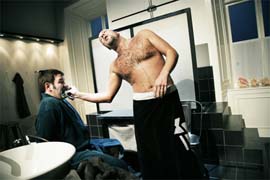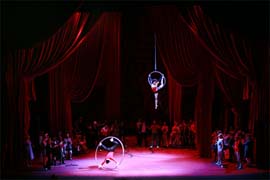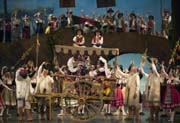
Jack Anderson
Updating Classics: When? Why?
Some Thoughts on Stagings
By Jack Anderson
There come times when people staging classic works of theater or dance feel an urge to update them, perhaps because they fear those pieces are now so familiar that they should be seen afresh. So drastic changes may be made in period and locale. The results are sometimes stimulating, sometimes merely peculiar.
I thought of such matters on a recent trip to Copenhagen when I saw two Danish classics: August Bournonville's "Napoli" (1842), by the Royal Danish Ballet, and Carl Nielsen's "Maskarade" (1906), by the Royal Danish Opera. "Napoli" was presented in the way it has always been: as an evocation of the 19th century Naples Bournonville knew and which inspired him to choreograph this sunny masterpiece. Nevertheless, Danish dancers occasionally wonder what "Napoli" might look like if transposed to some other, more recent, historical period. Thus far, though, the Royal Danish Ballet has declined to tinker.
 |
| Leander the hero being shaved by Henrik his valet in a modern Copenhagen house. Photo by Morten Abrahamsen. |
But the Royal Opera defied tradition with a new production of "Maskarade." The Danes often call "Maskarade" their national opera. But its potential appeal is more than local. Indeed, it deserves to be internationally better known than it is, for it sparkles with energy and melody, and its libretto is a genial one. Based on a comedy by the great 18th century Danish playwright Ludvig Holberg, it concerns a straitlaced father who tries to arrange a marriage for his daughter, despite her understandable objections: she's met a charming fellow at a masquerade during a Copenhagen season of masquerades, and it's love at first sight. But at another masquerade which she attends, defying her father, the romantic problems of all the opera's characters, who just happen to be there as well, are neatly and happily resolved.
Until now, Danish friends told me, the Royal Opera has always set "Maskarade" in the 18th century. But this fresh production, staged by Kasper Bech Holten and Morgan Alling and designed by Marie i Dali, is deliberately hip. It takes place in contemporary Copenhagen. The family house is an up-to-date one; the ingenious set allows its rooms to glide one by one across the stage for our inspection and, surprisingly, a bedroom is viewed from the ceiling. Characters wear jeans and t-shirts, there's an Elvis impersonation at the rather psychedelic masquerade, and the dance sequences are performed not by ballet dancers, but by spectacularly agile circus acrobats. Some operagoers considered the stage action much too busy. Others, myself among them, heartily enjoyed themselves.
Yet in one crucial way, this updating doesn't work. The father is not just a stuffy patriarch, but one who insists on an arranged marriage. In today's liberal Copenhagen, could such marriages even be conceivable? When I put that question to two sets of Danish friends, the answer in each case was a vociferous "Absolutely not." Well then, I wondered, when was the last period in which arranged marriages might have been possible? One group of friends started counting backward: for one reason or another, they ruled out the 1980's, the 70's, and the 60's, traveling through the decades until they concluded, "Marriages like that could still have happened in the 30's or the 20's."
Then, suddenly, we found ourselves virtually saying in unison, "If
you have to go that far back to make an updated 'Maskarade' totally plausible,
why update it at all? Why not leave it in the 18th century?"
 |
| Psychedelic Masquerade party with circus acrobats as entertainers. Photo by Morten Abrahamsen. |
Of course, no two eras are ever exact parallels in culture or customs. Still, if a work from one period is to be moved to a later time, there should be some convincing rationale for the transposition. The Danes giggled at the new "Maskarade," and so did I. Still, I'm not sure what the intent of the changes was, other than to be prankish, and I suspect this production will not be considered definitive.
Back home, I found that more giggles and comparable problems arose in another operatic staging (Jan. 25-Feb. 3): Gotham Chamber Opera's lively account of Rossini's scintillating "Il Signor Bruschino" (1813). Donald Eastman's designs placed the action in what looked like a modern apartment block, Martin Pakledinaz's costumes suggested the early 60's, and Robin Guarino's production had people crossing the stage on a bicycle and a motor scooter. The intimate Harry de Jur Playhouse at the Abrons Art Center suited this frolic perfectly. Nevertheless, the historically-minded might observe that, like "Maskarade," Rossini's comedy involves an arranged marriage. I'll leave it to experts on Italian mores to determine how possible such marriages were in 1960.
It's fascinating to ponder the ways producers and companies update classics. Take Shakespeare. Some of his plays and those of other Elizabethan dramatists are given unusual settings in an effort to suggest parallels between the text and later eras. Thus, in the late 50's, I saw the Old Vic in a famous production by Tyrone Guthrie of Shakespeare's cynical "Troilus and Cressida" set during World War I, a conflict that inspired considerable artistic cynicism. However, plays by Shakespeare and other Elizabethans have sometimes been done in modern dress, determinedly simple unobtrusive modern dress, to give those works a historically neutral look. Greek tragedies have also received such treatment. Economics may occasionally account for this: modern dress is surely less costly than fancy finery. But, such simplicity can also call attention to the timeless universality of a work's themes.
The Royal Danish Ballet may feel tempted to update the works of August Bournonville, their greatest choreographer and one of the key figures in 19th century balletic Romanticism. His masterpieces have quite specific settings (for instance, Naples, Flanders, Paris, Spain, the Scottish Highlands, the Danish countryside, and the outskirts of Copenhagen). Their historical periods can also be specific: thus the Flanders of "The Kermesse in Bruges" is that of the great 17th century Flemish painters, while "Napoli" and "Konservatoriet" are set in Bournonville's own time.
Yet such classics are now so well-known to Danish audiences that visual ennui may set in, creating a desire to view those works from a new perspective. So both designers and régisseurs might wonder what the results might be if familiar ballets were danced in unfamiliar or updated settings while keeping the choreography essentially intact, in contrast to, say, pieces like Matthew Bourne's "Swan Lake" or Mats Ek's "Giselle," which are choreographically original works inspired by well-known scenarios, just as countless playwrights through the centuries have been inspired by Greek dramas.
The specific work Danish stagers have speculated most about is "Napoli," with its picturesque street scenes and bustling crowds. Bustle is bustle in any age. So why not a 20th century "Napoli?" But when in the 20th century?
 |
| Thomas Lund and Tina Hojlund in ''Napoli''. Photo by Martin Mydtskov Ronne. |
Two specific periods have sometimes been suggested: Mussolini's 1930's and the "dolce vita" of the 50's and early 60's. Both, like Bournonville's original, would show how Gennaro, a brave fisherman, rescues his beloved Teresina, who has been captured by Golfo, a sea spirit who rules an entourage of nymphs in the Blue Grotto off Capri. In the 30's updating of "Napoli," Golfo might be a Fascist leader; in the dolce vita treatment, a Mafia boss.
Both versions are at least theoretically stageable. But both miss an important point about the original conception. Bournonville's Golfo is not just an ominous figure, he is a supernatural one, an embodiment of mindless lasciviousness. In contrast, the Golfos of the Fascist and dolce vita versions would have to become earthly, and presumably local, figures. Golfo is thereby diminished in import, although one feasible re-interpretation of Golfo might be to make him a drug dealer lording it over a bevy of stoned maidens, whose ranks Teresina is about to enter.
Producers who wish to update "Napoli," or other major Bournonville ballets, must face issues of specificity of time and place that Shakespearean producers are not always required to confront. Many of the settings in which Shakespeare's plays supposedly take place (for instance, the Illyria of "Twelfth Night," the Bohemia of "A Winter's Tale," and even the Denmark of "Hamlet" and the ancient Britain of "King Lear") are not actual places, but totally imagined ones in which real-seeming events occur. But Bournonville conceived of his ballets happening in specific locales: for instance, Naples, Bruges, or the Amager district of Denmark. The setting plays a crucial role in the ballet, as it does not always do in a Shakespeare play. Updating may work best, then, when the setting of the piece being transformed is already in itself somewhat vague. What did Illyria really look like? Who knows? And who cares? To confine ourselves to ballet, what architectural style should the palace of "Swan Lake" be in? It may not really matter. The period, in a sense, is immaterial.
 |
| August Bournonville: Napoli act III. Photo by Martin Mydtskov Ronne. |
However, updating "Napoli" might require considerable fussing over specific details of setting, period, characterizations, and moral implications, and there is also the danger that some of the "modern" touches added will be stylistically inappropriate. One might well wonder, then, why we should bother updating at all, other than for the sake of sheer visual novelty. Perhaps it is best to leave "Napoli" as it is: a vivid depiction of the Naples Bournonville was enchanted by when he visited there in 1841 and which he described in such pungent detail in the letters that have been collected under the title of "My Dearly Beloved Wife!: Letters from France and Italy 1841" (Alton, U.K.: Dance Books, 2005). A lovingly rehearsed and performed "Napoli" would bring to life a 19th century vision of that city that could still charm us and, perhaps, teach us a few gentle moral lessons about behavior. So, too, a "Maskarade" firmly rooted in the 18th century might revivify a society and an era, making Nielsen's evocation of Holberg's time our time, as well.
"Napoli" and "Maskarade" abound in local
color, and local color can add life to a production. If it happens to
be the life of some now vanished era, we should be thankful that the magic
of the theater provides us with opportunities to live for a while in another
time, as well as in our own.
| museums | NYTW mail | recordings | coupons | publications | classified |
